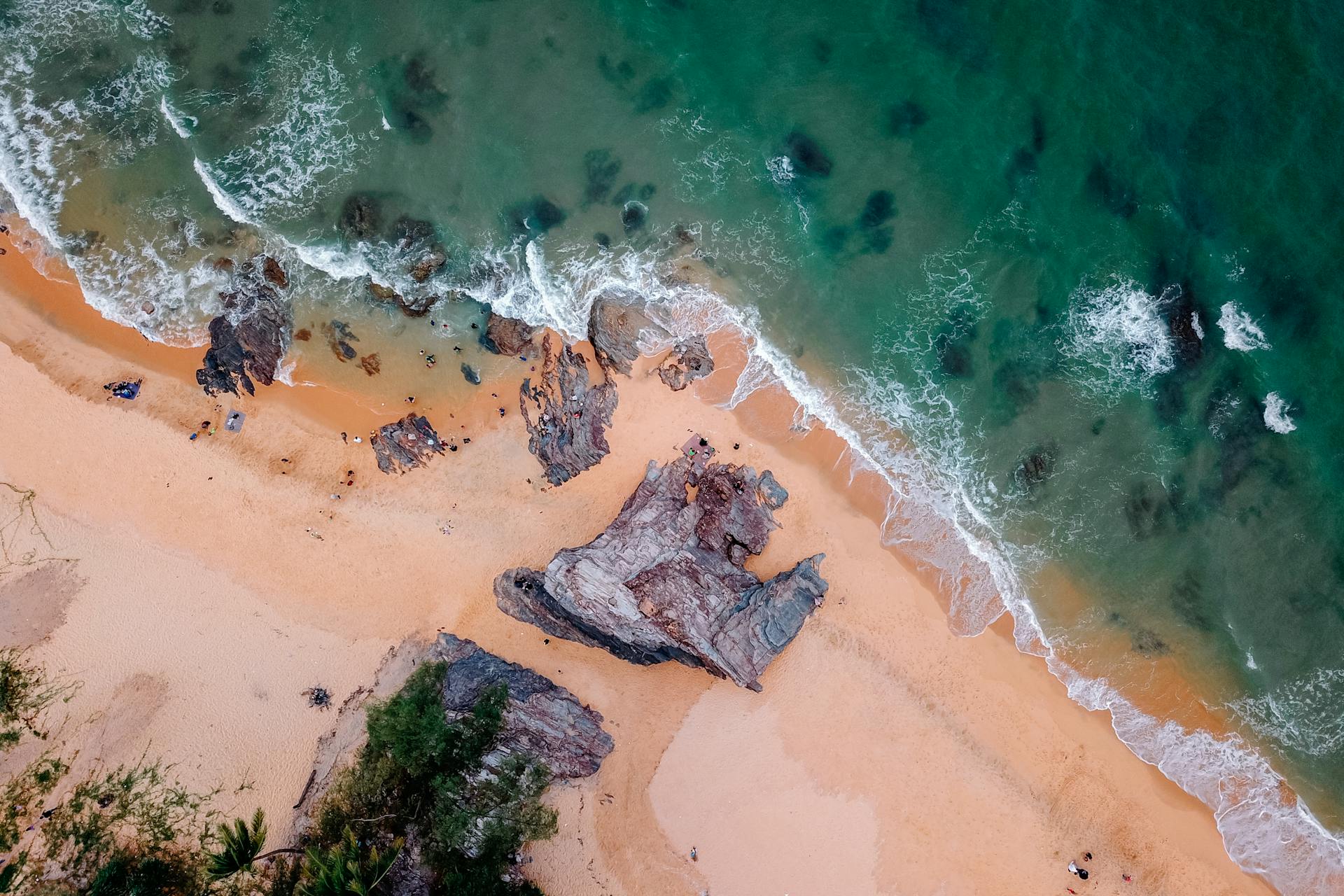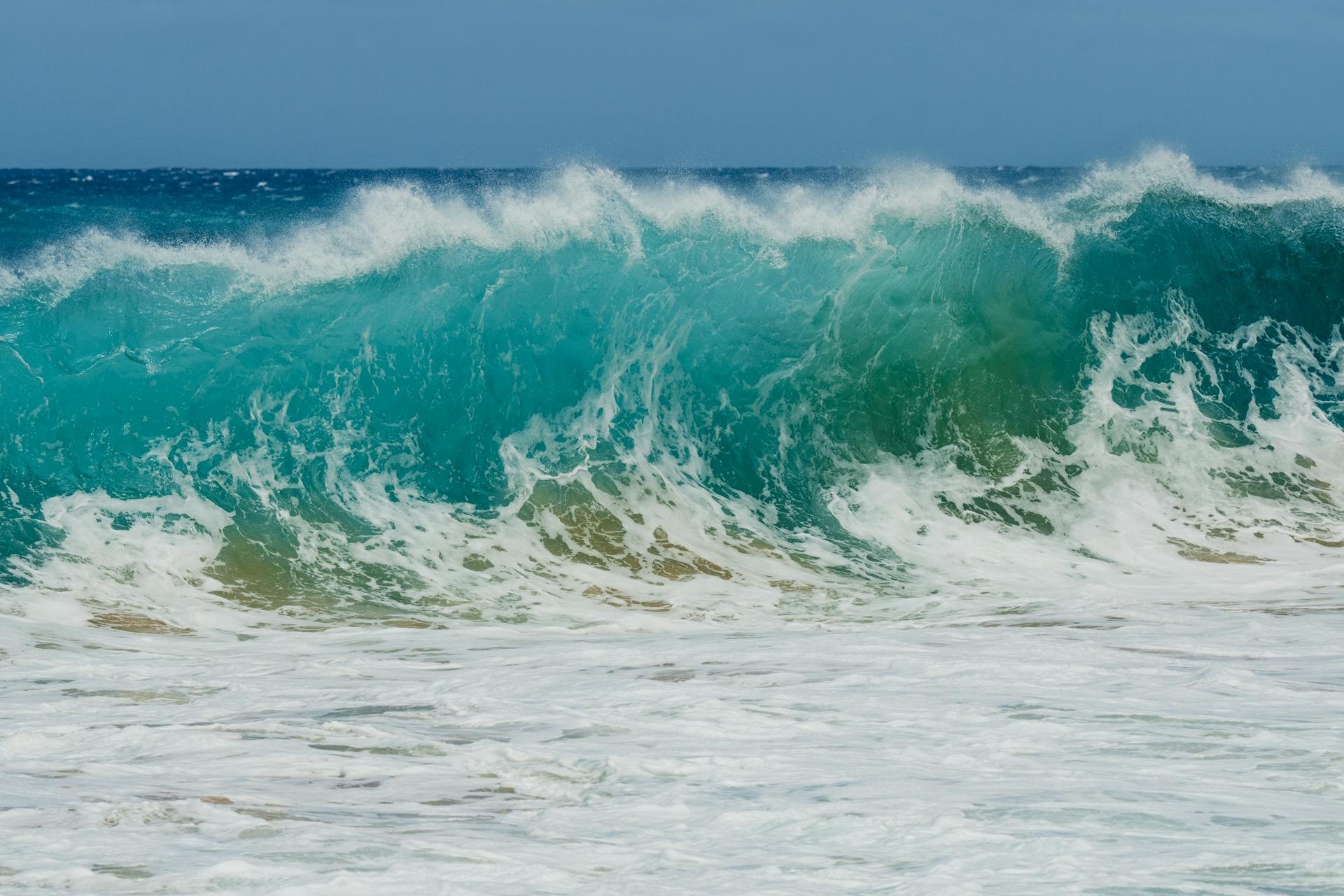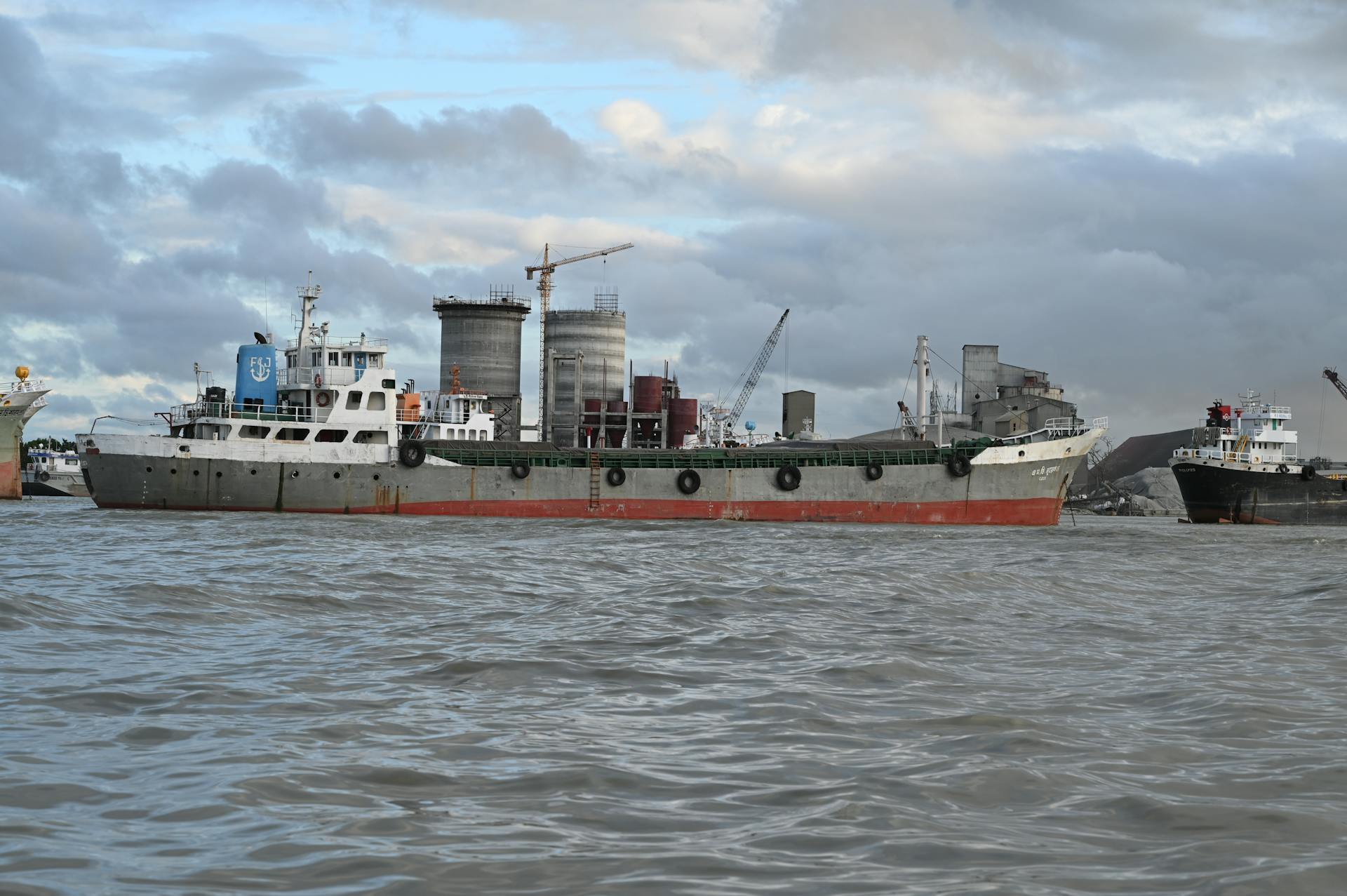
Shore power connection is a game-changer for mariners, allowing them to plug into a dock's electrical power grid and avoid running their engines while in port. This not only saves fuel but also reduces emissions and noise pollution.
Shore power connections are typically found at marinas, docks, and other waterfront facilities. They're designed to be safe and easy to use, with standard voltages and plug types.
The most common type of shore power connection is 120/240-volt, 50-amp, which is widely used in the United States. This type of connection can handle the power needs of most vessels, but it's essential to ensure your boat's electrical system is compatible.
In the United States, the National Electrical Manufacturers Association (NEMA) sets the standards for shore power connections, which include requirements for safety and compatibility.
What Is Shore Power Connection
Shore power connection is a vital aspect of RVing and maritime operations. It provides a safe and reliable way to connect your RV or ship to a power source, allowing you to power your appliances and systems.
The most common amperages of shore power are 20-amp, 30-amp, and 50-amp. Each offers different levels of power and supports varying electrical needs.
To connect to shore power, you'll need an RV power cord that matches the plug type of the electrical pedestal. For example, a 30-amp RV requires a 30-amp cord, while a 50-amp RV will require a 50-amp cord.
What Is Shore Power
Shore power is a type of electrical connection that allows your RV to draw power from a pedestal or outlet at a campsite or marina.
The power grid feeds the power conversion system, which converts the electrical power to the IEC standard.
You'll typically find a pedestal or outlet with 20-amp, 30-amp, or 50-amp electrical plugs, depending on the power capacity and type of shore power service offered.
These outlets require an RV power cord that matches the plug type, such as a 30-amp cord for a 30-amp RV or a 50-amp cord for a 50-amp RV.
The cord is equipped with a weatherproof casing to ensure it remains safe from outdoor conditions.
The power is delivered in 120 volts AC, but some larger RVs with 50-amp connections may have both 120V and 240V circuits.
The three most common amperages of shore power are 20-amp, 30-amp, and 50-amp, each offering different levels of power and supporting varying electrical needs.
Shore power connections are designed to be safe and seamless, with built-in safety features and systems to prevent accidents.
The power conversion system includes a converter, transformer, cooling and fire fighting system, and is typically housed in an e-house or container in the port.
Today
Today, shore power connections are becoming increasingly common, especially in cruise ship terminals. At Pier 66 in Seattle, a shore power connection is expected to reduce emissions from a cruise ship by 20%.
Many cruise lines that come to Seattle have already installed shore power technology, with more growth ahead. For instance, 54% of all home port calls are equipped to use shore power.
In fact, 54% of all home port calls at the Smith Cove Cruise Terminal at Pier 91 are equipped with shore power and expected to connect. This is a significant step towards reducing emissions and promoting sustainability.
Some cruise lines are leading the way in adopting shore power technology. For example, 100% of Holland America Line and Princess Cruises ships calling at Pier 91 are shore power capable.
Shore Power Connection Types
There are several types of shore power connections, each with its own set of characteristics and applications.
The most common type is the 30-amp connection, which is suitable for small boats and RVs.
It typically uses a 4-prong receptacle and is designed for 120-volt systems.
A 50-amp connection, on the other hand, is used for larger boats and RVs, and is also designed for 120-volt systems.
It uses a 4-prong receptacle, but has a higher amperage rating than the 30-amp connection.
Some shore power connections also feature a 240-volt system, which is used for high-power applications like electric dryers and water heaters.
20 Amp
A 20-amp shore power connection is the most basic type, typically used for smaller RVs or those with limited electrical needs.
It provides a standard level of power, similar to a standard household outlet used for small appliances like lamps or phone chargers.
This connection can deliver up to 2,400 watts of power (120 volts x 20 amps).
A 20-amp shore power connection is enough to run basic systems like lights, a small refrigerator, and possibly a fan or TV.
However, it's not sufficient to power heavy-duty appliances like air conditioning units or microwaves.
If you have a compact RV with minimal electrical needs, such as a pop-up camper or small travel trailer, a 20-amp shore power connection may be all you need.
30 Amp
The 30-amp power setup is one of the most common shore power connections found in RV parks and campgrounds.
A 30-amp connection is ideal for most recreational vehicles that require a moderate amount of power, offering a good balance of affordability and functionality.
This type of connection delivers up to 3,600 watts of power, which is typically enough for most RV appliances, including lights, refrigerator, microwave, and even a small air conditioner.
50 Amp
A 50-amp power connection is the highest level of shore power and delivers up to 12,000 watts of power.
This type of connection is typically found in larger, more luxurious RVs that require more electricity to run multiple high-power appliances simultaneously.
RVs with 50-amp connections may have both 120V and 240V circuits, allowing them to handle even more powerful systems.
Not all RV parks or campsites offer 50-amp service, so it's essential to check ahead of time before planning your stay.
If your RV requires more power than the 50-amp connection can provide, you risk damaging your electrical system or overloading the circuit.
You can use a 50-amp RV with a 30-amp shore power connection, but only with an adapter.
Secure Connections
Secure Connections are a top priority for pleasure craft and commercial vessels. A shore power connection is essentially the "life line" from the shore to the boat, ensuring technical equipment remains powered when not cruising.
Stainless steel and polyamide inlets are just a few examples of the materials used for shore power connections.
High-class connectors and cables are also essential for a secure connection.
A battery charger is a vital component of the shore power connection, recharging and maintaining the voltage for service, starter, and bow thruster batteries.
The WhisperPower battery charger or inverter/charger combi ensures the battery remains in perfect condition throughout the year.
Benefits and Impact
A shore power connection can make a big difference in reducing emissions. Using renewable power via a shore connection is a great way to reduce your emissions, and you can learn more about it in the eBook "50 great ways the maritime industry could cut its greenhouse gas emissions".
With a shore connection, you get effortless control with an intuitive interface for easy manual operation. This means you can use a user-friendly touchscreen for seamless control, making it convenient to switch between different power sources.
One of the key advantages of shore power connections is their ability to be equipped with a semi-automatic operating system. This intelligent system detects approaching vessels and automatically prepares the system for docking, making the process smoother and more efficient.
Reduce Emissions
Reducing emissions is a crucial step in minimizing the maritime industry's impact on the environment. A shore power connection can reduce emissions by providing a renewable power source.
Using renewable power via a shore connection can significantly reduce emissions, as highlighted in a fascinating eBook that lists 49 ways the maritime industry can cut its greenhouse gas emissions.
This approach can make a real difference, and it's an idea worth exploring further.
Advantages:
The advantages of a shore connection system are numerous and impressive. Effortless control with an intuitive interface makes manual operation a breeze, thanks to a user-friendly touchscreen.
This system is prepared for integration with built-in switchgear, which enables efficient circuit distribution to the plugs, enhancing convenience through seamless switching functionality.
A semi-automatic operating system can be equipped, which intelligently detects approaching vessels and automatically prepares the system for docking. It can even be synchronized with converters from any vendor.
Overload protection mechanisms are incorporated to prevent operational errors, and weak points in the structure are reinforced for enhanced safety measures.
The system features a cable management system compliant with Plug Solution PAS IEC 80005-3 standards.
Troubleshooting and Maintenance
Common issues with RV shore power can be frustrating, but knowing where to start can make all the difference. Shore power issues can be resolved with the right troubleshooting techniques.
To begin, check the shore power cord for damage, as a broken or frayed cord can prevent power from flowing to your RV. A damaged cord is a common problem with RV shore power.
Regular maintenance is key to preventing shore power issues. This includes inspecting your shore power cord regularly and replacing it if necessary. I've seen many RVers neglect this step, only to encounter problems down the line.
Common Problems and Troubleshooting
RV shore power issues can be frustrating, but many problems can be resolved with simple troubleshooting.
One common issue is a faulty shore power cord, which can cause a loss of power to your RV's electrical system.
A blown fuse or tripped circuit breaker is often the culprit behind a power outage, so check your RV's electrical panel to see if this is the case.
Loose connections or corroded terminals on your shore power cord can also prevent your RV from receiving power.
A simple way to resolve this issue is to inspect and clean your shore power cord's terminals and connections.
If you're experiencing a power surge, it may be due to a faulty RV electrical panel or a problem with your shore power cord.
To troubleshoot a power surge, check your RV's electrical panel for signs of overheating or damage.
A faulty ground fault circuit interrupter (GFCI) can also cause a power outage, so check your RV's electrical system to see if this is the issue.
In some cases, a power outage can be caused by a problem with your RV's electrical wiring, which can be a more complex issue to resolve.
If you're not comfortable troubleshooting electrical issues yourself, it's best to consult a professional RV electrician.
Main Ingredients for a Reliable Supply
A reliable supply of power is crucial for your boat's systems to function properly. Complete cable sets for shore to boat connection are a must-have, available in 15 or 25 meter lengths and 16 or 32 amps.
Thru-hull stainless steel inlets are another essential component, ensuring a secure and durable connection. Plugs to fit the inlets are also necessary, making it easy to connect and disconnect.
Industrial cable reels are a great way to store excess cable, keeping your workspace organized and clutter-free. This helps prevent damage to the cable and makes it easier to manage.
Yesterday
Yesterday, the Port created an innovative shore power infrastructure for cruise ships in Seattle at the former Terminal 30 cruise facility, collaborating with Holland America Group in 2004.
Every time a cruise ship docks in Seattle, it takes an average of 10 hours to offload guests, load provisions, welcome new guests on board, and prepare for its next departure.
Providing connections to clean electricity allows ships to turn off diesel engines during this time, reducing air pollution and greenhouse gas emissions that contribute to climate change.
About 25% of a cruise ship's total emissions in Puget Sound can be avoided by plugging into shore power at berth.
An average cruise ship plugging into shore power at Terminal 91 saves the greenhouse gas equivalent of a typical car driving 30 road trips from Seattle to New York.
Charging Batteries
Shore power can charge your RV's batteries, but the process depends on your RV's electrical system and configuration.
Most RVs have a converter/charger that converts 120V AC power from the shore power connection to 12V DC power to charge the batteries.
This is especially useful for maintaining battery power when your RV is stationary and plugged into shore power.
However, charging your batteries using shore power is relatively slow compared to using a dedicated battery charger or alternator.
It may take several hours to fully charge your batteries, depending on their capacity and the power output of the converter.
If your RV's batteries aren't charging while connected to shore power, there could be a problem with your RV's electrical system.
A faulty converter/charger or tripped battery disconnect switch could be the culprit.
To troubleshoot, check the battery disconnect switch to make sure it's in the "on" position, and then test the converter/charger for any error codes or signs of damage.
Here are some common issues to look out for:
- Faulty converter/charger
- Tripped battery disconnect switch
By understanding how shore power charging works, you can keep your RV's batteries in good condition and enjoy a smooth and efficient charging experience.
Alternatives and Future
The Port of Seattle and the Northwest Seaport Alliance are working together to eliminate emissions from Seattle's working waterfront. They're building the infrastructure to support shore power, which is a clean alternative to traditional diesel engines.
According to the Port, they want to have the infrastructure in place when their tenants are ready to make the switch. The Northwest Ports Clean Air Strategy is a collaborative effort to reduce air pollution from maritime sources.
The Port of Seattle has a comprehensive plan to address climate change and air pollution from maritime sources, known as the Maritime Climate and Air Action Plan (MCAAP). This plan charts a course to zero emissions and is a key part of their efforts to reduce pollution.
Can I Use Solar?
You can use your RV's solar power system while connected to shore power. This is a great option for RVers who want to make the most of their solar panels.

Yes, solar power doesn't interfere with the shore power system, and the two can work simultaneously. This means you can keep your solar panels collecting energy during the day, even if you're plugged into shore power.
Your RV's solar power system can charge your batteries or power smaller appliances like lights, fans, or small electronics. This is especially useful for low-draw appliances that don't require a lot of power.
Shore power provides a continuous supply of electricity for higher-demand appliances, like your refrigerator or air conditioning. This is especially important at night or during cloudy weather when solar output is insufficient.
Alternative Marine
Alternative Marine Power is a game-changer for vessels in port. It allows them to turn off their gensets and take power from shore, reducing emissions and fuel consumption.
Container vessels and passenger vessels are among the most common users of AMP solutions. They're required to use shore power in EU ports from 2030 onwards.
AMP is also used by RoRo vessels, LNG carriers, tankers, ferries, and mega yachts. These vessels can reduce their environmental impact by switching to shore power while in port.
You can even use your RV's solar power system while connected to shore power. This means your solar panels can generate power to charge your batteries or power smaller appliances, while shore power provides a continuous supply of electricity for higher-demand appliances.
The maritime industry is increasingly relying on shore power, and ports are building the infrastructure to support them. The Port and the Northwest Seaport Alliance are working together to provide clean electrical power to ships berthed at their ports.
Shore power is becoming a reality, with the Port of Seattle and the Northwest Seaport Alliance investing $7.6 million to bring clean electrical power to ships. This is part of a larger effort to eliminate emissions from Seattle's working waterfront.
Real-World Applications
Damen's shore connection solution is perfect for shipowners who want to meet regulations and reduce their environmental impact. By connecting to shore power, vessels can even charge their batteries for electric ship operations.
Over 150 shore power solutions have been delivered by Wärtsilä to ships, with their solution being the reference for the Long Beach port – the first to make shore power mandatory.
The world's largest zero-emissions lightweight catamaran ferry, ordered by Buquebus and built by Incat Tasmania, will have the world's largest DC shore charging system.
Pier 66
Pier 66 is a great example of how shore power can make a real difference in reducing emissions. As of October 28, 2024, it was the last facility to be shore power enabled, thanks to a $44 million investment.
This investment equipped all three of the Port's cruise berths with shore power, allowing cruise ships to plug into the Seattle City Light grid and turn off their fuel-based engines.
Shore power at Pier 66 can help avoid an estimated 3,000 metric tons of CO2 if all home port ships connect.
Customer Cases
Wärtsilä has delivered over 150 shore power solutions to ships, making a significant impact on reducing emissions.
The company's solution was actually the reference point for the Long Beach port, which was the first to make shore power mandatory.
The world's largest zero-emissions lightweight catamaran ferry, ordered by Buquebus and built by Incat Tasmania, will feature the world's largest DC shore charging system.
This impressive system will play a crucial role in making the ferry's operations as environmentally friendly as possible.
Wärtsilä's shore power solutions are a testament to the company's commitment to innovation and sustainability in the maritime industry.
Regional Cargo Facilities
The Northwest Seaport Alliance is leading the way in modernizing regional cargo facilities to reduce emissions and improve efficiency. The NWSA has installed shore power at Terminal 5 in Seattle, with funding from the State of Washington.
TOTE Maritime's terminal in Tacoma has been equipped with shore power since 2010, allowing two vessels to plug in and charge while docked. The NWSA is also adding shore power to its modernized Pier 3 and Pier 4 facilities in Tacoma.

Part of the funding for these upgrades comes from the EPA's Diesel Emission Reduction Act program and the TransAlta Coal Transition Grant Program's Energy Technology Fund. The Northwest Seaport Alliance plans to expand shore power to other terminals in Tacoma and Seattle.
The TOTE vessels on regular service between Tacoma and Alaska call weekly and use the shore power system, reducing their emissions while at dock.
Sources
- https://www.renogy.com/blog/rv-shore-power-explained-everything-you-need-to-know
- https://www.wartsila.com/marine/products/ship-electrification-solutions/shore-power
- https://www.whisperpower.com/power-distribution/shore-power-connection
- https://www.damen.com/equipment/green-solutions/greenify-your-vessel/shore-power-connection
- https://www.portseattle.org/blog/past-present-and-future-shore-power
Featured Images: pexels.com


